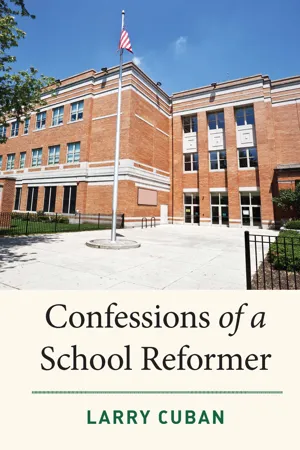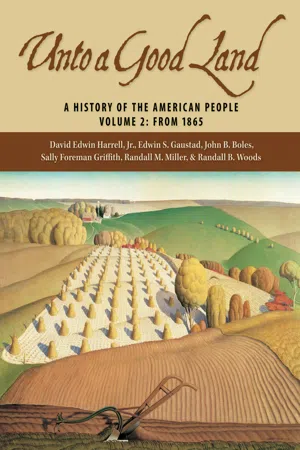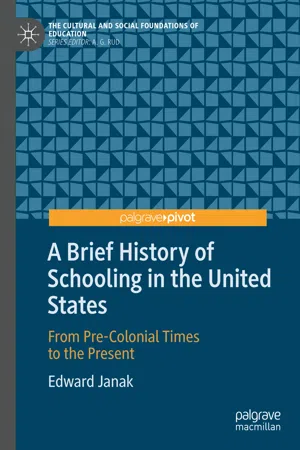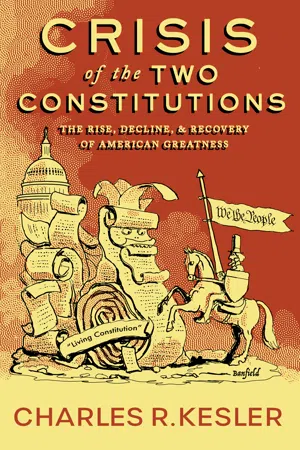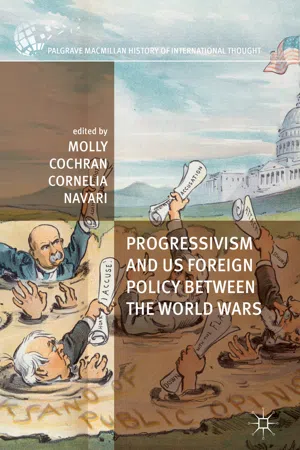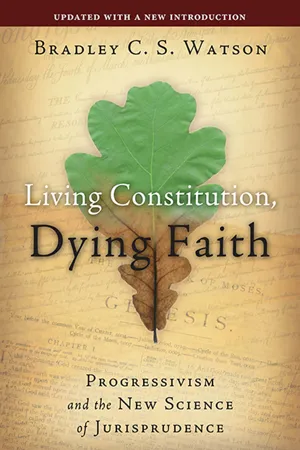History
Progressives in Politics
Progressives in politics refers to a political movement that emerged in the late 19th and early 20th centuries in the United States. Progressives sought to address social and economic inequalities, improve working conditions, and combat political corruption. They advocated for government intervention to regulate big business and protect the welfare of the public, leading to significant reforms in areas such as labor, consumer protection, and women's suffrage.
Written by Perlego with AI-assistance
Related key terms
9 Key excerpts on "Progressives in Politics"
- eBook - ePub
- Larry Cuban(Author)
- 2022(Publication Date)
- Harvard Education Press(Publisher)
For example, Republican President Teddy Roosevelt and Democratic President Woodrow Wilson called themselves Progressives. Philosopher John Dewey and measurement expert Edward Thorndike belonged to the movement. Settlement house founder Jane Addams and teacher union leader Margaret Haley saw themselves as Progressives. Efficiency expert Frederick Winslow Taylor and wealthy businessman and later Illinois Governor John Altgeld considered themselves Progressives. A polyglot bunch of reformers in government, business, community improvement, and education sheltered under the wide umbrella called Progressivism.Even a century later, historians cannot yet agree on a definition of Progressivism, who led the movement, what areas of American life were substantively altered as a result of the movement, and how long the movement lasted. So if historians today differ on answers to such basic questions, readers may be disappointed that I cannot do better than my peers in answering these questions.7What historians do agree on, however, are the impulses that drove those who called themselves Progressives to work hard for decades to improve American society. Moving from largely rural agriculture in the eighteenth and nineteenth centuries to an industrial and urban-based economy in the decades following the Civil War transformed the economy, society, and culture of the nation. Steel, beef, and oil trusts, as these monopolies were then called, paid low wages for workers and set high prices for consumers. Cities grew as manufacturing and transportation centers. Rural migrants and European immigrants flocked to these cities to get jobs that paid barely enough to cover rent and food.Political machines oiled by bribery and nepotism governed these urban centers, caring little for the disease, crime, and poverty endemic to densely packed slums. Reform-minded mayors pledging to solve these problems came and went, but political machines endured. Worsening conditions even more were the unpredictable and periodic economic panics (1873 and 1893) that threw hundreds of thousands of workers out of jobs, overwhelmed city leaders, and frightened city-dwelling middle-class families, many of whom had moved into emerging suburbs. - eBook - ePub
The Revolution of ’28
Al Smith, American Progressivism, and the Coming of the New Deal
- Robert Chiles(Author)
- 2018(Publication Date)
- Cornell University Press(Publisher)
In response, scholars have defined progressivism as everything from a reactionary defense against a “status revolution” to a rationalization of government in response to modernizing technological and economic forces; from a movement to homogenize the citizenry and control social conflict on the part of the middle class to a set of tools for dealing with industrial society imported from late nineteenth-century Europe by cosmopolitan intellectuals, to a drive to establish the political ascendancy of the “public interest” over interest group, class, or partisan goals. 2 Studies have thus located the core progressive constituency variously: old-money “Mugwump” reformers, the professional middle class of the new industrial order, worldly scholars and social activists, settlement house pioneers—even urban machine politicians. 3 Moreover, some scholars have questioned whether a “progressive movement” existed at all, and others have suggested that there was no ideological uniformity across the various political drives of the reputedly progressive decades, merely shared “clusters of ideas” and “social languages” that were drawn on by sundry interest groups. 4 Indeed, some studies have demonstrated that the rhetoric of progressivism was easily appropriated by partisans and injected into the public sphere toward nonreformist, highly divisive ends. 5 Amid this whirl of academic ambivalence over the “age of reform,” there is room for a diversity of “progressives” or even “progressivisms” within the working definition of that concept. 6 The objective of the present study is more tangible and precise: to chart the historical forces that produced the specific progressivism. practiced by Alfred E. Smith as governor of New York - eBook - ePub
Unto a Good Land
A History of the American People, Volume 2: From 1865
- David Edwin Harrell, Edwin S. Gaustad, John B. Boles, Sally Foreman Griffith(Authors)
- 2005(Publication Date)
- Eerdmans(Publisher)
24
Progressivism in American Politics, 1901 to World War I
Chapter 24 at a Glance The Core of the Progressive Agenda The Urban Social Justice Movement Saving the WASP Empire Local and State Political Reform Reorganizing American Cities Progressivism in the States Electoral Reform—Democratic and Undemocratic States Provide Models for Progressive Legislation Theodore Roosevelt and the Selling of National Progressivism Theodore Roosevelt Takes Center Stage The Extension of Regulation and Trustbusting Political Victory and the Square Deal A Beginning for Conservation Roosevelt Drifts to the Left Competing Progressive Visions Roosevelt Picks His Successor Taft Alienates the Progressives The Rift between Roosevelt and Taft The Election of 1912 Wilsonian Progressivism The Scholar President Congress Backs the President Expanding the New Freedom Conclusion: The Legacy of Political ProgressivismT HE ANXIETIES CAUSED by rapid social and economic change at the turn of the century defined the Progressive Era as a time of causes and crusades. The reform sentiment of the period took on added significance because most progressives looked to government to restore the American dream, and they relished political combat. The governmental reforms of the Gilded Age, including civil service reform and the growing professionalization of the Washington bureaucracy, had set the stage for the progressive movement, and the election of 1896 had provided an agenda for the progressive presidents of the early twentieth century—Theodore Roosevelt, William Howard Taft, and Woodrow Wilson. Progressives backed a broad array of social, economic, and political reforms; no one person was likely to embrace all of them. The federal government enacted the era’s most far-reaching legislation, but progressives won their first political successes at the local and state levels.Nationally, the Progressive Era witnessed a renaissance of presidential leadership, conspicuously lacking in the Gilded Age. Roosevelt and Wilson are generally ranked among the nation’s greatest chief executives, and Taft was a competent (if politically clumsy) and somewhat underrated president. Surrounding these presidents were a colorful and vigorous cast of political characters whose thought and actions helped shape modern America. - Katherine A.S. Sibley, Katherine A.S. Sibley(Authors)
- 2014(Publication Date)
- Wiley-Blackwell(Publisher)
Richard McCormick in several works, but especially in his book From Realignment to Reform: Political Change in New York State 1893–1910 (1981), argued that progressivism was characterized by the rise of interest groups and the decline of political parties, a model that works well with the changes in social welfare politics. Beginning in the early 1990s, Theda Skocpol, a political scientist and sociologist, brought a social science-infused approach to the New Left historical concerns as she began to track the evolution of American social welfare from the 1800s to the present (see below). And from a third direction, Steven Diner’s A Very Different Age: Americans of the Progressive Era, sought to synthesize the period by focusing on how Americans sought to control their lives and the government through the upheavals at the end of nineteenth century, an echo of the older Hofstadter concern, but one fleshed out by the latest research in social history and using industrialism, corporate capitalism, progressive reform and the emergence of large-scale organizations as his “backdrop” (Diner 1998: 8). Skocpol has also led a movement to examine the means by which these organizations exerted political power and sought change in civil reform and social welfare matters. Riffing off Tocqueville’s observation that Americans had a propensity to form associations for all manner of activities, from social, to political, to religious, rather than producing a “government or administration” (1997: 457), Skocpol concludes that the antebellum period and the subsequent Progressive Era proliferation of voluntary associations was not simply a “by-product of commercialization and urbanization” (1997: 466–467). Instead, this trend was heavily influenced by the provision of national travel and communications networks supported by the central government- eBook - ePub
Reconsidering American Liberalism
The Troubled Odyssey Of The Liberal Idea
- James Young(Author)
- 2018(Publication Date)
- Routledge(Publisher)
10 The Problem of ProgressivismTHE ORIGINS of the modern American state lie in the ideas and institutional changes of the Progressives. The state that the Progressive movement fostered, which began an attempt to make peace with modernity, produced results that can hardly have been what the populists had in mind. Nevertheless, the incipient modern state did introduce into American politics a conception of activist government, which the populists had previously championed, and it also adopted some of their institutional remedies. As with populism, the historiography of progressivism is extremely complex, so much so that some historians have proposed discarding the very term as conceptually useless.1 This solution has not taken hold, so it is necessary to try to sort out at least some of the conflicting viewpoints. Part of the difficulty no doubt lies in the fact that progressivism, unlike populism, was a national movement, which manifested itself at the federal, state, and local levels of government and which was subject to considerable ideological debate and political infighting. Moreover, there was often a gap between the fierce moral rhetoric of the movement and its actual accomplishments. Therefore, some observers have been moved, perhaps not entirely without reason, to question the motives of the reformers. One might add that the moral rhetoric of the political leaders often contrasted with the relativism of the Progressive philosophers.Progressivism, though heir to a good deal of populist rhetoric and ideology, was primarily an urban, middle-class phenomenon; it lasted for a considerable period of time—conventionally, from 1900 to 1920. However, perhaps more important than who the Progressives were and where they were located was the fact that they, unlike the populists, produced a great deal of social and political theory. Further, to a great extent, those ideas continue to be of great importance in shaping contemporary liberal thought. To some extent, reform liberals today might be said to be living still on the intellectual capital of progressivism. - eBook - ePub
A Brief History of Schooling in the United States
From Pre-Colonial Times to the Present
- Edward Janak(Author)
- 2019(Publication Date)
- Palgrave Pivot(Publisher)
Horace Mann to take on the purpose of schooling, the political and social challenges facing reformers in this period caused a significant overhaul of the public schools. Reforms came on every level of schooling, from the frazzled teacher in the one-room schoolhouse on the prairie to the equally frazzled teacher of English in the large urban school that was running more and more like a factory. Prior to this period, both teachers feared for their jobs politically; both had to “do more with less”; and by the period’s end, both had to turn their schools into community centers.Progressive education is one of the better known, and more popular, periods; if you ask most classroom teachers today what they are, they will (often incorrectly) label themselves “progressive.” It is popular and makes one feel good about oneself to be progressive; why, the opposite is regressive, and who wants to be that? To truly be a progressive, though, one must be well schooled in the politics and philosophy behind the movement.What Are the Philosophical Roots of Progressivism?
- Key terms : pragmatism, progressivism
- Key figures : John Locke, Charles Darwin, William James, John Dewey, and Jean-Jacques Rousseau
The roots of progressivism actually lie in the philosophy ofpragmatism, which encourages the quest for things that work well, are useful, and, by proxy, encourages all humans to do our best in everything. Pragmatists believe that knowledge is culturally and socially based and comes from problems which must be solved. Humans are social beings, and the main goal of humanity is to discover each individual’s role in society. Pragmatists believe the environment is the most important factor in shaping humanity; many pragmatists take that notion a step further and argue that, by extension, too much civilization is harmful to a person’s development. However, pragmatists believe that the primary means of coming to know is through discovery and the scientific method , whether individually or societally. Pragmatists argue that ideas cannot be separated from conduct—to have ideas is to know effects and consequences, a notion that would give rise to the behaviorist movement (explored in more detail in Chap. 5 - eBook - ePub
Crisis of the Two Constitutions
The Rise, Decline, and Recovery of American Greatness
- Charles R. Kesler(Author)
- 2021(Publication Date)
- Encounter Books(Publisher)
Most Progressive critics of the Constitution were not as quasi-Marxist as Beard, who hid neither his economic determinism nor his philosophical debt to the theorists of class conflict, including Aristotle and Karl Marx. The majority took a different line, more Hegelian than Marxist, and owing much as well to the German and English historical schools and various forms of evolutionary thought descending from Herbert Spencer and Charles Darwin. Despite their intellectual diversity, these Progressive political and social scientists mounted a common criticism of the Constitution as time-bound and anachronistic. They argued our political system rested on certain eighteenth-century fantasies like the state of nature, natural rights, and the social compact, already exposed as illusory by generations of nineteenth-century political and social scientists. But no eighteenth-century doctrine could possibly fit the needs of twentieth-century human beings and societies; the problem was not so much the injustice of the framers’ ideas as their primitiveness and obsolescence. Above all, they didn’t grasp the historical relativity of their own “truths.” The old freedom had to be replaced, therefore, by a modern, up-to-date freedom – and here the Progressive political and social scientists joined hands with the Progressive historians – which had to be more collectivist or socialist in spirit.As their new critics saw it, the American founders had held to an atomistic and egoistic view of man – a view that, at its best, reflected their world of individual proprietors, family farms carved out of the wilderness, and religion centered on the drama of individual salvation or damnation. That spirit needed to be corrected now by a more well-rounded or social view, made urgent by the changed conditions of life and labor in a new industrial century. But the new view was made possible or thinkable, in the most profound sense, by Hegel’s and his disciples’ philosophy of history, with its teachings that all thought is a child of its time, that history itself is a progressive or evolutionary process, and that later ages therefore enjoyed a fuller self-consciousness and a higher realization of freedom and morality than preceding ones. Though political rhetoric is often designed to mystify, blame, or distract, in this case it clarified: the Progressives really did believe in progress, and not as something devoutly to be wished but as something inevitable - Molly Cochran, Cornelia Navari, Molly Cochran, Cornelia Navari, Molly Cochran, Cornelia Navari(Authors)
- 2017(Publication Date)
- Palgrave Macmillan(Publisher)
New World Order, it was a reformed Progressivism that was speaking.Progressivism Before World War I
Progressivism had begun as a social movement in America in the late nineteenth century, gradually developing into a political movement under the aegis of Theodore Roosevelt, in what became known as the Progressive Era. The term signified a range of diverse political and social schemes and political pressure groups, supporting issues from tax reform and conservation to trade unionism and women’s suffrage , not always united. But progressives generally rejected the prevalent Social Darwinism of the time and believed that social problems of poverty , violence and greed, racism, and class warfare could best be addressed by providing education, a safe environment, and an efficient workplace. They aspired to a reformed and empowered federal system led by an enlightened and nationally minded executive. In foreign policy, Progressivism revolved around the ‘war question’—whether and under what conditions the United States should join the Allies in fighting Germany during World War I. The progressives eventually gave a qualified ‘yes’ to the question, provided that the war effort was directed to reforming the international system and ending colonialism.Many progressives, including US President Theodore Roosevelt, had seen no conflict between imperialism and reform at home. Both were forms of uplift and improvement. They saw in Puerto Rico and the Philippines —the new colonies America had acquired in the Spanish American war —an opportunity to further the progressive agenda around the world. Others, however, especially after the violence of the 1898 Philippine insurrection (which the US administration refused to term a war) became increasingly vocal in their opposition to US foreign intervention and imperialism . Still others argued that foreign ventures would detract from much-needed domestic political and social reforms. Under the leadership of US Senator Robert La Follette , progressive opposition to foreign intervention increased under the ‘dollar diplomacy’ policies of Republican President- eBook - ePub
Living Constitution, Dying Faith
Progressivism and the New Science of Jurisprudence
- Bradley C. S. Watson(Author)
- 2020(Publication Date)
- Intercollegiate Studies Institute(Publisher)
4Progressive Political LeadershipProgressivism as an intellectual and political movement amounted to the politicization of the twin doctrines of social Darwinism and pragmatism, supplemented by occasional dashes of German thought in the form of Hegel and Weber.1 By harnessing these doctrines for political ends—as Dewey hoped—progressives were able to usher in a new order in American politics. Commencing in the early years of the twentieth century, political and judicial actors borrowed freely from pragmatic and Darwinist accounts of politics, constitutionalism, and human life. The age-old question of “what works,” politically, was increasingly divorced from a sense of constitutional restraint. Instead it was informed by an organic conception of a state unlimited in principle and whose only end was growth and development according to certain contemporary understandings of democracy. The initial dissenters from “right” social Darwinism, including the pragmatists, were, after all, as Richard Hofstadter has argued, “thinkers who did not quarrel with the fundamental assumption that the new ideas had profound import for the theory of man and of society. They simply attempted to wrest Darwinism from the [right] social Darwinists by showing that its psychological and social consequences could be read in totally different terms from those assumed by the more conservative thinkers who had preceded them in the field.”2This democratic bias was supplemented by the progressive belief in the desirability, and perhaps necessity, of a coterie of administrative experts, versed in the new scientific methods, who were in the best position to apply the new understandings of politics to the ever-changing political organism.3
Index pages curate the most relevant extracts from our library of academic textbooks. They’ve been created using an in-house natural language model (NLM), each adding context and meaning to key research topics.
